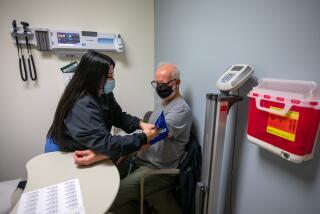Patients Find Instructions Hard to Swallow
- Share via
“Take two aspirin and call me in the morning.”
The medical reality is that many people don’t--even if their health depends on it. Compliance has become the nagging headache of American health care, and there’s no over-the-counter remedy to ease the pain. In fact, the challenge of getting patients to follow even the simplest prescriptions and instructions has emerged as one of the most difficult and serious questions in all of medicine today.
The statistics are depressing. A survey by the Bayer Foundation reveals that fully half of men told by their doctors to regularly take aspirin to reduce their risk of heart attack or stroke don’t do it.
According to research reported by the National Council on Patient Information and Education, noncompliance with prescription medicine ranges from 30% to 50%. Transdermal patches such as Nicoderm--designed to wean people away from smoking--have come under fire as a heart attack risk because users continued to smoke while wearing them, even though instructions explicitly warn them not to do so.
“We don’t take this problem seriously enough, even though we know it exists,” says Robert P. Navarro, associate vice president for provider services at Health Net, a billion-dollar Woodland Hills-based health maintenance organization. “It’s underrated; I don’t think we realize how important it may be. . . . In many cases, the lack of performance of certain therapies may really be due to patient noncompliance.”
While it’s true that some people stop taking medication the moment they feel a bit better and others double their doses in hopes of speeding their healing process, it’s important to keep in mind here that the issue is seldom better information and education.
The overwhelming majority of patients who don’t follow instructions know that they aren’t in compliance. The fundamental issue here is human behavior; a problem frequently more intractable than curing disease.
“The important issue is changing behavior,” acknowledges Dr. Peter H. Rheinstein, the director of medicine at the Food and Drug Administration’s Office of Health Affairs. “The pills don’t work if they’re still in the bottle and neither do the condom and diaphragm if they’re still on the shelf.”
As new prescription drugs proliferate, the FDA is coming to be just as concerned with issues of compliance as medical efficacy.
“There are obviously drugs where lack of compliance is a clear safety problem,” Rheinstein says. “You’re going to see the agency ask the manufacturers to assure compliance as a condition of approval.”
In other words, it’s not enough that prescription drugs are medically effective; pharmaceutical companies and other health care providers will increasingly be required to make sure that their offerings are designed for easy compliance.
For example, says Health Net’s Navarro, there is already a trend in the pharmaceutical industry to design drugs that require a single daily dose instead of multiple daily dosages.
But the compliance issue is likely to force far more profound changes in doctor-pharmacist-patient relationships.
We may well see certain medications only prescribed in intelligent “programmable pillboxes” that beep and whistle when the time comes to take your medicine. What’s more, these pillboxes could provide a record of consumption for the pharmacist when the patient returns to refill the prescription. Technology will be designed to enforce responsibility.
Similarly, we may see some medications prescribed for transdermal patches instead of pills precisely because the doctor does not trust the patient to comply with the rigors of a pill-taking prescription regimen.
Doctors may be ethically and legally required to assure that their patients actually adhere to their prescriptions.
Some FDA observers contend that many prescription drugs won’t be approved for over-the-counter sales precisely because of compliance concerns. We may even see arguments--and lawsuits--between doctors and pharmacists over which method of drug dispensing is likeliest to ensure compliance.
“Pharmacists are becoming much more responsible for what happens,” observes University of Rhode Island pharmacy professor Paul Larrat, who has extensively studied patient compliance, “and they are going to have to consider adopting and adapting some of those standards.”
Indeed, the legal issues surrounding compliance may become one of the most important drivers of innovation in this area.
So just as doctors now practice “defensive testing” to minimize malpractice exposure, the medical Establishment may soon move to “defensive dispensing” to minimize the risks of liability associated with noncompliance.
With an aging population and a greater need for “geriatric pharmacology,” Larrat and Rheinstein point out, compliance assumes an even greater urgency.
Ultimately, the issue of compliance boils down to one of responsibility. Are doctors and pharmacists responsible for compliance? Or is it the responsibility of patients and their families?
The answers to those questions will go a long way in determining the quality of health care over the next decade.






